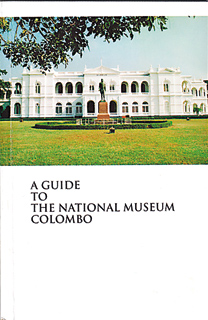Pick up a guide book on your way to the ‘Katuge’
In the good old days the Museum was referred to as the ‘Katuge’ (Skeleton House) in Sinhala. It is still so for many. Why did everyone start calling it the ‘Katuge’? The recently released ‘Guide to the National Museum – Colombo’ provides the answer. The skeleton of a large whale of enormous size hung on the ceiling of the Natural Science wing of the museum gave the name.

The well-illustrated Guide is the fulfilment of a long felt need. Now the visitor has a well- compiled publication to guide him through the galleries which have been refurbished. It has been edited by Professor Leelananda Prematilleke, the Senior Archaeologist and Museologist (he was also Consultant and Project Planner of the refurbishing programme), and Ranjith Hewage, Superintendent of the Colombo Museum, who was the Coordinator of the refurbishment programme.
It has been a long journey for the Colombo Museum since January 1, 1877, when Governor Sir William Henry Gregory (1872-77) – a keen observer of Asian Culture and Natural Science heritage – took the initiative in establishing it. Incidentally, before he came over he had served as the Chairman of the British Museum Foundation Committee.
One time the sole museum in the country, today the Colombo Museum is one of nine at national level. The others are the Dutch Museum, the Independence Memorial Museum and the National Museum of Natural History in Colombo, the Folk Museum in Anuradhapura, National Museums in Kandy, Ratnapura and Galle and the Maritime Museum in Galle. These were established after 1942. These are administered by the Department of National Museums.
With the Guide in hand, one can traverse through the different galleries much more meaningfully than earlier. Particularly the overseas visitors will find it extremely useful. In fact, when I dropped in at the museum last week the number of foreigners outnumbered the locals at that particular time.
The Guide takes one through the different eras starting with the Pre and Proto-historic periods detailing the information relating to the exhibits belonging to them. Skeletal remains from a cave at Pothana, Sigiriya dated to 3916-3709 BC display interesting data of funerary habits, the Guide states.
The next few chapters deal with the Anuradhapura Period (4th century BC-end of 10th century AC), the Polonnaruwa Period (11th– 13th centuries), the Transitional Period when the capital moved from the Dry Zone to the Wet Zone first to Dambadeniya followed by quick changes to Yapahuva, Kurunegala, then to Gampola, Kotte and Sitawaka (13th-16th centuries) and the Kandy Period. A brief history and significant events are mentioned about each Period with relevant photographs.
The visitor is then taken to a new gallery on Stone Antiquities where all the stone antiquities collected since 1877 are displayed. These are divided into Buddhist and Hindu sculpture, decorative elements and inscriptions. In the Painting Gallery are copies of ancient mural paintings and the water colour collection of a British artist (1801-86) – 28 in number- depicting ancient archaeological ruins as well as contemporary city life.
Two galleries – Textiles and Ceramics – have been newly set up. Separate chapters also describe Coins & Currency, Flags & Banners, Arts & Crafts, Arms & Armaments, and Traditional Rituals galleries. The editors must be commended for using more space for pictures keeping the text to a minimum. The photographs are well reproduced as a result of the use of quality paper.
A job well done, the Guide is sold at the Museum bookshop at a price affordable to many. Pick a copy before you start visiting the galleries during your next visit.
Follow @timesonlinelk
comments powered by Disqus


